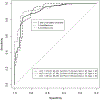Efficacy of the Fluorescein Tear Breakup Time Test in Dry Eye
- PMID: 31513046
- PMCID: PMC6893123
- DOI: 10.1097/ICO.0000000000002148
Efficacy of the Fluorescein Tear Breakup Time Test in Dry Eye
Abstract
Purpose: To examine the effects of volume and method on fluorescein tear breakup time (TBUT) values and to evaluate test efficacy in an independent sample free of selection bias.
Methods: Subjects were assessed using a battery of dry eye tests (DETs). Efficacy study: Subjects were randomized to the DET, standard strip, and liquid NaFl on separate days. A masked examiner measured TBUTs from video recordings. Verification study: Subjects were investigated for efficacy using volumes of 5.0 and 2.0 μL mL of NaFl for TBUT.
Results: Efficacy study: 46 subjects completed the study. Log-transformed TBUTs were significantly different, normal subjects versus dry subjects, for all 3 methods (all P values < 0.001). Area under the curves (AUCs), cut-points, sensitivity, and specificity were 1) DET: 0.873, 4.4 seconds, 0.97, and 0.67, respectively; 2) 2.0 mL: 0.901, 3.22 seconds, 0.90, and 0.87, respectively; and 3) standard strip: 0.912, 3.42 seconds, 0.97, and 0.80, respectively. Verification study: Data splitting analysis for the 2.0 μL data (n = 174 dry subjects and 97 normal subjects) generated an AUC of 0.917 and a cut-point of 6.05 seconds for a sensitivity of 0.87 and a specificity of 0.81. The 5.0 μL sample yielded an AUC of 0.940, with a sensitivity and specificity of 0.92 and 0.83, respectively, at a cut-point of 5.5 seconds.
Conclusions: Little difference in TBUT was found using the 3 clinical methods with video recordings. Analysis using liquid NaFl suggests that the TBUT test has excellent diagnostic accuracy and that a cut-point of 5.3 to 6.0 seconds is the optimum to differentiate normals from persons with dry eye.
Conflict of interest statement
The authors have no conflicts of interest for the subject matter of this paper.
Figures


References
-
- Bron AJ, de Paiva CS, Chauhan SK , et al. TFOS DEWS II pathophysiology report. Ocul Surf 2017; 15:438–510. - PubMed
-
- Wolffsohn JS, Arita R, Chalmers R , et al. TFOS DEWS II Diagnostic Methodology report. Ocul Surf 2017; 15:539–574. - PubMed
-
- Cardona G, Seres C, Quevedo L , et al. Knowledge and use of tear film evaluation tests by spanish practitioners. Optom Vis Sci 2011; 88:1106–1111. - PubMed
-
- Xue AL, Downie LE, Ormonde SE , et al. A comparison of the self-reported dry eye practices of New Zealand optometrists and ophthalmologists. Ophthalmic Physiol Opt 2017; 37:191–201. - PubMed
-
- Downie LE, Rumney N, Gad A , et al. Comparing self-reported optometric dry eye clinical practices in Australia and the United Kingdom: is there scope for practice improvement? Ophthalmic Physiol Opt 2016; 36:140–151. - PubMed

